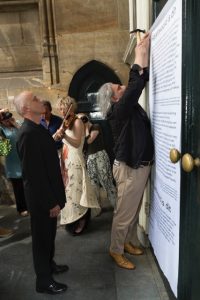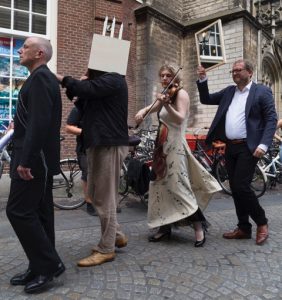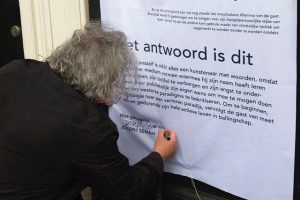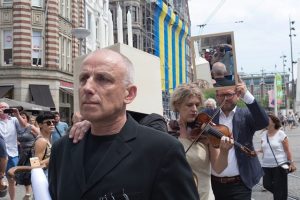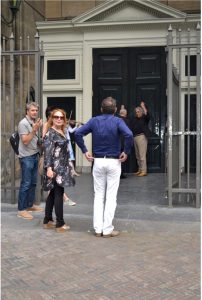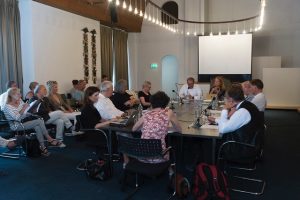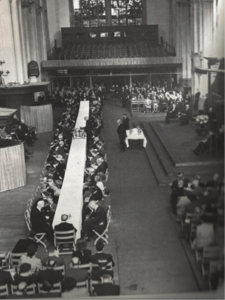Socialism For The Rich, Capitalism For The Poor: An Interview With Noam Chomsky
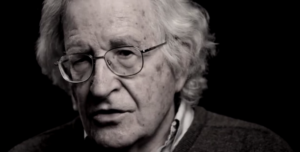 The United States is rapidly declining on numerous fronts — collapsing infrastructure, a huge gap between haves and have-nots, stagnant wages, high infant mortality rates, the highest incarceration rate in the world — and it continues to be the only country in the advanced world without a universal health care system. Thus, questions about the nature of the US’s economy and its dysfunctional political system are more critical than ever, including questions about the status of the so-called American Dream, which has long served as an inspiration point for Americans and prospective immigrants alike. Indeed, in a recent documentary, Noam Chomsky, long considered one of America’s voices of conscience and one of the world’s leading public intellectuals, spoke of the end of the American Dream. In this exclusive interview for Truthout, Chomsky discusses some of the problems facing the United States today, and whether the American Dream is “dead” — if it ever existed in the first place.
The United States is rapidly declining on numerous fronts — collapsing infrastructure, a huge gap between haves and have-nots, stagnant wages, high infant mortality rates, the highest incarceration rate in the world — and it continues to be the only country in the advanced world without a universal health care system. Thus, questions about the nature of the US’s economy and its dysfunctional political system are more critical than ever, including questions about the status of the so-called American Dream, which has long served as an inspiration point for Americans and prospective immigrants alike. Indeed, in a recent documentary, Noam Chomsky, long considered one of America’s voices of conscience and one of the world’s leading public intellectuals, spoke of the end of the American Dream. In this exclusive interview for Truthout, Chomsky discusses some of the problems facing the United States today, and whether the American Dream is “dead” — if it ever existed in the first place.
C.J. Polychroniou: Noam, in several of your writings you question the usual view of the United States as an archetypical capitalist economy. Please explain.
Noam Chomsky: Consider this: Every time there is a crisis, the taxpayer is called on to bail out the banks and the major financial institutions. If you had a real capitalist economy in place, that would not be happening. Capitalists who made risky investments and failed would be wiped out. But the rich and powerful do not want a capitalist system. They want to be able to run the nanny state so when they are in trouble the taxpayer will bail them out. The conventional phrase is “too big to fail.”
The IMF did an interesting study a few years ago on profits of the big US banks. It attributed most of them to the many advantages that come from the implicit government insurance policy — not just the featured bailouts, but access to cheap credit and much else — including things the IMF researchers didn’t consider, like the incentive to undertake risky transactions, hence highly profitable in the short term, and if anything goes wrong, there’s always the taxpayer. Bloomberg Businessweek estimated the implicit taxpayer subsidy at over $80 billion per year.
Much has been said and written about economic inequality. Is economic inequality in the contemporary capitalist era very different from what it was in other post-slavery periods of American history?
The inequality in the contemporary period is almost unprecedented. If you look at total inequality, it ranks amongst the worse periods of American history. However, if you look at inequality more closely, you see that it comes from wealth that is in the hands of a tiny sector of the population. There were periods of American history, such as during the Gilded Age in the 1920s and the roaring 1990s, when something similar was going on. But the current period is extreme because inequality comes from super wealth. Literally, the top one-tenth of a percent are just super wealthy. This is not only extremely unjust in itself, but represents a development that has corrosive effects on democracy and on the vision of a decent society.
What does all this mean in terms of the American Dream? Is it dead?
The “American Dream” was all about class mobility. You were born poor, but could get out of poverty through hard work and provide a better future for your children. It was possible for [some workers] to find a decent-paying job, buy a home, a car and pay for a kid’s education. It’s all collapsed — and we shouldn’t have too many illusions about when it was partially real. Today social mobility in the US is below other rich societies.
Is the US then a democracy in name only?
The US professes to be a democracy, but it has clearly become something of a plutocracy, although it is still an open and free society by comparative standards. But let’s be clear about what democracy means. In a democracy, the public influences policy and then the government carries out actions determined by the public. For the most part, the US government carries out actions that benefit corporate and financial interests. It is also important to understand that privileged and powerful sectors in society have never liked democracy, for good reasons. Democracy places power in the hands of the population and takes it away from them. In fact, the privileged and powerful classes of this country have always sought to find ways to limit power from being placed in the hands of the general population — and they are breaking no new ground in this regard.
Concentration of wealth yields to concentration of power. I think this is an undeniable fact. And since capitalism always leads in the end to concentration of wealth, doesn’t it follow that capitalism is antithetical to democracy?
Concentration of wealth leads naturally to concentration of power, which in turn translates to legislation favoring the interests of the rich and powerful and thereby increasing even further the concentration of power and wealth. Various political measures, such as fiscal policy, deregulation, and rules for corporate governance are designed to increase the concentration of wealth and power. And that’s what we’ve been seeing during the neoliberal era. It is a vicious cycle in constant progress. The state is there to provide security and support to the interests of the privileged and powerful sectors in society while the rest of the population is left to experience the brutal reality of capitalism. Socialism for the rich, capitalism for the poor.
So, yes, in that sense capitalism actually works to undermine democracy. But what has just been described — that is, the vicious cycle of concentration of power and wealth — is so traditional that it is even described by Adam Smith in 1776. He says in his famous Wealth of Nations that, in England, the people who own society, in his days the merchants and the manufacturers, are “the principal architects of policy.” And they make sure that their interests are very well cared for, however grievous the impact of the policies they advocate and implement through government is on the people of England or others.
Now, it’s not merchants and manufacturers who own society and dictate policy. It is financial institutions and multinational corporations. Today they are the groups that Adam Smith called the masters of mankind. And they are following the same vile maxim that he formulated: All for ourselves and nothing for anyone else. They will pursue policies that benefit them and harm everyone else because capitalist interests dictate that they do so. It’s in the nature of the system. And in the absence of a general, popular reaction, that’s pretty much all you will get.
Let’s return to the idea of the American Dream and talk about the origins of the American political system. I mean, it was never intended to be a democracy (actually the term always used to describe the architecture of the American political system was “republic,” which is very different from a democracy, as the ancient Romans well understood), and there had always been a struggle for freedom and democracy from below, which continues to this day. In this context, wasn’t the American Dream built at least partly on a myth?
Sure. Right through American history, there’s been an ongoing clash between pressure for more freedom and democracy coming from below and efforts at elite control and domination from above. It goes back to the founding of the country, as you pointed out. The “founding fathers,” even James Madison, the main framer, who was as much a believer in democracy as any other leading political figure in those days, felt that the United States political system should be in the hands of the wealthy because the wealthy are the “more responsible set of men.” And, thus, the structure of the formal constitutional system placed more power in the hands of the Senate, which was not elected in those days. It was selected from the wealthy men who, as Madison put it, had sympathy for the owners of wealth and private property.
This is clear when you read the debates of the Constitutional Convention. As Madison said, a major concern of the political order has to be “to protect the minority of the opulent against the majority.” And he had arguments. If everyone had a vote freely, he said, the majority of the poor would get together and they would organize to take away the property of the rich. That, he added, would be obviously unjust, so the constitutional system had to be set up to prevent democracy.
Recall that Aristotle had said something similar in his Politics. Of all political systems, he felt that democracy was the best. But he saw the same problem that Madison saw in a true democracy, which is that the poor might organize to take away the property of the rich. The solution that he proposed, however, was something like a welfare state with the aim of reducing economic inequality. The other alternative, pursued by the “founding fathers,” is to reduce democracy.
Now, the so-called American Dream was always based partly in myth and partly in reality. From the early 19th century onward and up until fairly recently, working-class people, including immigrants, had expectations that their lives would improve in American society through hard work. And that was partly true, although it did not apply for the most part to African Americans and women until much later. This no longer seems to be the case. Stagnating incomes, declining living standards, outrageous student debt levels, and hard-to-come-by decent-paying jobs have created a sense of hopelessness among many Americans, who are beginning to look with certain nostalgia toward the past. This explains, to a great extent, the rise of the likes of Donald Trump and the appeal among the youth of the political message of someone like Bernie Sanders.
After World War II, and pretty much up until the mid-1970s, there was a movement in the US in the direction of a more egalitarian society and toward greater freedom, in spite of great resistance and oppression from the elite and various government agencies. What happened afterward that rolled back the economic progress of the post-war era, creating in the process a new socio-economic order that has come to be identified as that of neoliberalism?
Beginning in the 1970s, partly because of the economic crisis that erupted in the early years of that decade and the decline in the rate of profit, but also partly because of the view that democracy had become too widespread, an enormous, concentrated, coordinated business offensive was begun to try to beat back the egalitarian efforts of the post-war era, which only intensified as time went on. The economy itself shifted to financialization. Financial institutions expanded enormously. By 2007, right before the crash for which they had considerable responsibility, financial institutions accounted for a stunning 40 percent of corporate profit. A vicious cycle between concentrated capital and politics accelerated, while increasingly, wealth concentrated in the financial sector. Politicians, faced with the rising cost of campaigns, were driven ever deeper into the pockets of wealthy backers. And politicians rewarded them by pushing policies favorable to Wall Street and other powerful business interests. Throughout this period, we have a renewed form of class warfare directed by the business class against the working people and the poor, along with a conscious attempt to roll back the gains of the previous decades.
Now that Trump is the president-elect, is the Bernie Sanders political revolution over?
That’s up to us and others to determine. The Sanders “political revolution” was quite a remarkable phenomenon. I was certainly surprised, and pleased. But we should remember that the term “revolution” is somewhat misleading. Sanders is an honest and committed New Dealer. His policies would not have surprised Eisenhower very much. The fact that he’s considered “radical” tells us how far the elite political spectrum has shifted to the right during the neoliberal period. There have been some promising offshoots of the Sanders mobilization, like the Brand New Congress movement and several others.
There could, and should, also be efforts to develop a genuine independent left party, one that doesn’t just show up every four years but is working constantly at the grassroots, both at the electoral level (everything from school boards to town meetings to state legislatures and on up) and in all the other ways that can be pursued. There are plenty of opportunities — and the stakes are substantial, particularly when we turn attention to the two enormous shadows that hover over everything: nuclear war and environmental catastrophe, both ominous, demanding urgent action.
Copyright, Truthout.
How did we reach a historically unprecedented level of inequality in the United States? A new documentary, Requiem for The American Dream, turns to the ever-insightful Noam Chomsky for a detailed explanation of how so much wealth and power came to be concentrated in so few hands. Click here to order this DVD by making a donation to Truthout today!
C.J. POLYCHRONIOU
C.J. Polychroniou is a political economist/political scientist who has taught and worked in universities and research centers in Europe and the United States. His main research interests are in European economic integration, globalization, the political economy of the United States and the deconstruction of neoliberalism’s politico-economic project. He is a regular contributor to Truthout as well as a member of Truthout’s Public Intellectual Project. He has published several books and his articles have appeared in a variety of journals, magazines, newspapers and popular news websites. Many of his publications have been translated into several foreign languages, including Croatian, French, Greek, Italian, Portuguese, Spanish and Turkish.
